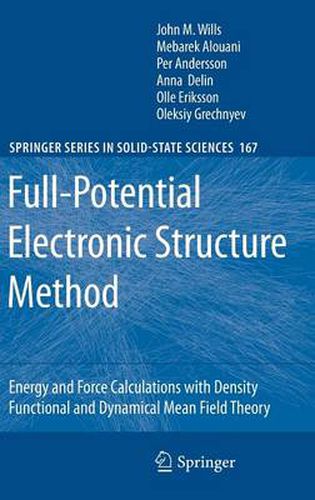Readings Newsletter
Become a Readings Member to make your shopping experience even easier.
Sign in or sign up for free!
You’re not far away from qualifying for FREE standard shipping within Australia
You’ve qualified for FREE standard shipping within Australia
The cart is loading…






This title is printed to order. This book may have been self-published. If so, we cannot guarantee the quality of the content. In the main most books will have gone through the editing process however some may not. We therefore suggest that you be aware of this before ordering this book. If in doubt check either the author or publisher’s details as we are unable to accept any returns unless they are faulty. Please contact us if you have any questions.
This is a book describing electronic structure theory and application within the framework of a methodology implemented in the computer code RSPt. In 1986, when the code that was to become RSPt was developed enough to be useful, it was one of the ?rst full-potential, all-electron, relativistic implem- tations of DFT (density functional theory). While RSPt was documented p- asitically in many publications describing the results of its application, it was many years before a publication explicitly describing aspects of the method appeared. In the meantime, several excellent all-electron, full-potential me- ods had been developed, published, and become available. So why a book about RSPt now? The code that became RSPt was initially developed as a personal research tool, rather than a collaborative e?ort or as a product. As such it required some knowledge of its inner workings to use, and as it was meant to be m- imally ?exible, the code required experience to be used e?ectively. These - tributes inhibited, but did not prevent, the spread of RSPt as a research tool. While applicable across the periodic table, the method is particularly useful in describing a wide range of materials, including heavier elements and c- pounds, and its ?exibility provides targeted accuracy and a convenient and accurate framework for implementing and assessing the e?ect of new models.
$9.00 standard shipping within Australia
FREE standard shipping within Australia for orders over $100.00
Express & International shipping calculated at checkout
This title is printed to order. This book may have been self-published. If so, we cannot guarantee the quality of the content. In the main most books will have gone through the editing process however some may not. We therefore suggest that you be aware of this before ordering this book. If in doubt check either the author or publisher’s details as we are unable to accept any returns unless they are faulty. Please contact us if you have any questions.
This is a book describing electronic structure theory and application within the framework of a methodology implemented in the computer code RSPt. In 1986, when the code that was to become RSPt was developed enough to be useful, it was one of the ?rst full-potential, all-electron, relativistic implem- tations of DFT (density functional theory). While RSPt was documented p- asitically in many publications describing the results of its application, it was many years before a publication explicitly describing aspects of the method appeared. In the meantime, several excellent all-electron, full-potential me- ods had been developed, published, and become available. So why a book about RSPt now? The code that became RSPt was initially developed as a personal research tool, rather than a collaborative e?ort or as a product. As such it required some knowledge of its inner workings to use, and as it was meant to be m- imally ?exible, the code required experience to be used e?ectively. These - tributes inhibited, but did not prevent, the spread of RSPt as a research tool. While applicable across the periodic table, the method is particularly useful in describing a wide range of materials, including heavier elements and c- pounds, and its ?exibility provides targeted accuracy and a convenient and accurate framework for implementing and assessing the e?ect of new models.